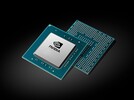NVIDIA Quadro T2000 (Laptop) vs NVIDIA Quadro RTX 3000 (Laptop) vs NVIDIA Quadro T1000 Max-Q
NVIDIA Quadro T2000 (Laptop)
► remove from comparisonThe Nvidia Quadro T2000 for laptops is a professional mobile graphics card that is based on the Turing architecture (TU117 chip). It is based on the consumer desktop GTX 1650 Ti with comparable clock speeds and therefore currently between a mobile GTX 1650 and GTX 1660 Ti. The chip is manufactured in 12nm FinFET at TSMC.
The GPU features 1024 shaders, 64 texture mapping units and 32 ROPs. The 4 GB GDDR5 memory is connected with a 128-bit memory interface and clocked at 2000 MHz. At a TGP of 60W, the clock speeds are specified from 1575 MHz (base) to 1785 MHz (boost).
The Turing generation did not only introduce raytracing for the RTX cards, but also optimized the architecture of the cores and caches. According to Nvidia the CUDA cores offer now a concurrent execution of floating point and integer operations for increased performance in compute-heavy workloads of modern games. Furthermore, the caches were reworked (new unified memory architecture with twice the cache compared to Pascal). This leads to up to 50% more instructions per clock and a 40% more power efficient usage compared to Pascal. In contrary to the faster Quadro RTX cards (e.g. Quadro RTX 3000), the T1000 and T2000 don not feature raytracing and Tensor cores.
NVIDIA Quadro RTX 3000 (Laptop)
► remove from comparisonThe Nvidia Quadro RTX 3000 for laptops is a professional high-end graphics card for big and powerful laptops and mobile workstations. It is based on the same TU106 chip as the consumer GeForce RTX 2070 (mobile) but with reduced shaders, clock speeds and memory bandwidth.
The Quadro GPUs offer certified drivers, which are optimized for stability and performance in professional applications (CAD, DCC, medical, prospection, and visualizing applications). The performance in these areas is therefore much better compared to corresponding consumer GPUs.
| Variante | Shader | TGP (W) | Base (MHz) | Boost (MHz) |
| Quadro RTX 4000 Desktop | 2304 | 160 | 1005 | 1545 |
| Quadro RTX 3000 Mobile | 1920 | 80 | 945 | 1380 |
| Quadro RTX 3000 Max-Q | 1920 | 70 | 870 | 1380 |
| Quadro RTX 4000 Max-Q | 2304 | 65 | 765 | 1305 |
| Quadro RTX 4000 Max-Q | 2304 | 60 | 600 | 1215 |
| GeForce RTX 2070 Mobile | 2304 | 115? | 1215 | 1440 |
Features
NVIDIA manufacturers the TU106 chip on a 12 nm FinFET process and includes features like Deep Learning Super Sampling (DLSS) and Real-Time Ray Tracing (RTRT), which should combine to create more realistic lighting effects than older GPUs based on the company's Pascal architecture (if the games support it). The Quadro RTX 3000 is also DisplayPort 1.4 ready, while there is also support for HDMI 2.0b, HDR, Simultaneous Multi-Projection (SMP) and H.265 video en/decoding (PlayReady 3.0).
Performance
In professional applications, the Quadro RTX 3000 can be faster GeForce RTX 2070 due to the optimized drivers and bigger VRAM.
The high power consumption of the RTX3000 makes the card most suited for big and heavy laptops. The slower Max-Q variant is intended for thinner laptops.
NVIDIA Quadro T1000 Max-Q
► remove from comparison
The Nvidia Quadro T1000 with Max-Q Design is a professional mobile graphics card that is based on the Turing architecture (TU117 chip). Compared to the consumer GTX 1650, the Quadro T1000 features less CUDA cores / shaders (768 versus 896). The chip is manufactured in 12nm FinFET at TSMC. Compared to the normal Quadro T1000, the Max-Q variants are clocked lower and work in a more efficient state. Currently, we know of two variants with different clock speeds and power consumptions (35 and 40 W).
| Model | Shader | TGP (W) | Base (MHz) | Boost (MHz) |
| Quadro T1000 Mobile | 768 | 50 | 1395 | 1455 |
| Quadro T1000 Max-Q | 768 | 40 | 1230 | 1455 |
| Quadro T1000 Max-Q | 768 | 35 | 795 | 1455 |
| Quadro T2000 Mobile | 1024 | 60 | 1575 | 1785 |
| GeForce GTX 1650 Mobile | 896 | 50 | 1395 | 1560 |
The Quadro T1000 is a mobile graphics card that is based on the Turing architecture (TU116 chip). Compared to the faster RTX 2000 GPUs (e.g. RTX 2060), the T1000 integrates no Raytracing or Tensor cores. Due to the same boost clock as the mobile T1000, the Max-Q variants can perform similar with sufficient cooling.
The Turing generation did not only introduce raytracing for the RTX cards, but also optimized the architecture of the cores and caches. According to Nvidia the CUDA cores offer now a concurrent execution of floating point and integer operations for increased performance in compute-heavy workloads of modern games. Furthermore, the caches were reworked (new unified memory architecture with twice the cache compared to Pascal). This leads to up to 50% more instructions per clock and a 40% more power efficient usage compared to Pascal.
Thanks to the low power consumption, the Max-Q T2000 GPU can be used in thin and light laptops. The used TU116 chip is manufactured in 12nm FFN at TSMC.
| NVIDIA Quadro T2000 (Laptop) | NVIDIA Quadro RTX 3000 (Laptop) | NVIDIA Quadro T1000 Max-Q | ||||||||||||||||||||||||||||||||||||||||||||||||||||||||||||||||||||||||||||||||||||||||||||||||||||||||||||||||||||||||||||||||||||||||||||||||||||||||||
| Quadro Turing Series |
|
|
| |||||||||||||||||||||||||||||||||||||||||||||||||||||||||||||||||||||||||||||||||||||||||||||||||||||||||||||||||||||||||||||||||||||||||||||||||||||||||
| Codename | N19P-Q3 | N19E-Q1 | N19P-Q1 | |||||||||||||||||||||||||||||||||||||||||||||||||||||||||||||||||||||||||||||||||||||||||||||||||||||||||||||||||||||||||||||||||||||||||||||||||||||||||
| Architecture | Turing | Turing | Turing | |||||||||||||||||||||||||||||||||||||||||||||||||||||||||||||||||||||||||||||||||||||||||||||||||||||||||||||||||||||||||||||||||||||||||||||||||||||||||
| Pipelines | 1024 - unified | 1920 - unified | 768 - unified | |||||||||||||||||||||||||||||||||||||||||||||||||||||||||||||||||||||||||||||||||||||||||||||||||||||||||||||||||||||||||||||||||||||||||||||||||||||||||
| Core Speed | 1575 - 1785 (Boost) MHz | 945 - 1380 (Boost) MHz | 795 / 1230 - 1455 (Boost) MHz | |||||||||||||||||||||||||||||||||||||||||||||||||||||||||||||||||||||||||||||||||||||||||||||||||||||||||||||||||||||||||||||||||||||||||||||||||||||||||
| Memory Speed | 8000 MHz | 14000 MHz | 8000 MHz | |||||||||||||||||||||||||||||||||||||||||||||||||||||||||||||||||||||||||||||||||||||||||||||||||||||||||||||||||||||||||||||||||||||||||||||||||||||||||
| Memory Bus Width | 128 Bit | 192 Bit | 128 Bit | |||||||||||||||||||||||||||||||||||||||||||||||||||||||||||||||||||||||||||||||||||||||||||||||||||||||||||||||||||||||||||||||||||||||||||||||||||||||||
| Memory Type | GDDR5 | GDDR6 | GDDR5 | |||||||||||||||||||||||||||||||||||||||||||||||||||||||||||||||||||||||||||||||||||||||||||||||||||||||||||||||||||||||||||||||||||||||||||||||||||||||||
| Max. Amount of Memory | 4 GB | 6 GB | 4 GB | |||||||||||||||||||||||||||||||||||||||||||||||||||||||||||||||||||||||||||||||||||||||||||||||||||||||||||||||||||||||||||||||||||||||||||||||||||||||||
| Shared Memory | no | no | no | |||||||||||||||||||||||||||||||||||||||||||||||||||||||||||||||||||||||||||||||||||||||||||||||||||||||||||||||||||||||||||||||||||||||||||||||||||||||||
| API | DirectX 12_1, OpenGL 4.6 | DirectX 12_1, OpenGL 4.6 | DirectX 12_1, OpenGL 4.6 | |||||||||||||||||||||||||||||||||||||||||||||||||||||||||||||||||||||||||||||||||||||||||||||||||||||||||||||||||||||||||||||||||||||||||||||||||||||||||
| Power Consumption | 60 Watt | 80 Watt | 35 - 40 Watt | |||||||||||||||||||||||||||||||||||||||||||||||||||||||||||||||||||||||||||||||||||||||||||||||||||||||||||||||||||||||||||||||||||||||||||||||||||||||||
| Transistors | 4.7 Billion | 10.8 Billion | ||||||||||||||||||||||||||||||||||||||||||||||||||||||||||||||||||||||||||||||||||||||||||||||||||||||||||||||||||||||||||||||||||||||||||||||||||||||||||
| technology | 12 nm | 12 nm | 12 nm | |||||||||||||||||||||||||||||||||||||||||||||||||||||||||||||||||||||||||||||||||||||||||||||||||||||||||||||||||||||||||||||||||||||||||||||||||||||||||
| Notebook Size | medium sized | large | medium sized | |||||||||||||||||||||||||||||||||||||||||||||||||||||||||||||||||||||||||||||||||||||||||||||||||||||||||||||||||||||||||||||||||||||||||||||||||||||||||
| Date of Announcement | 27.05.2019 | 27.05.2019 | 27.05.2019 | |||||||||||||||||||||||||||||||||||||||||||||||||||||||||||||||||||||||||||||||||||||||||||||||||||||||||||||||||||||||||||||||||||||||||||||||||||||||||
| Features | DLSS, Raytraycing, VR Ready, G-SYNC, Vulkan, Multi Monitor |
Benchmarks
3DM Vant. Perf. total + NVIDIA Quadro RTX 3000 (Laptop)
specvp12 sw-03 + NVIDIA Quadro T2000 (Laptop)
Cinebench R15 OpenGL 64 Bit + NVIDIA Quadro T2000 (Laptop)
GFXBench T-Rex HD Offscreen C24Z16 + NVIDIA Quadro RTX 3000 (Laptop)
Average Benchmarks NVIDIA Quadro T2000 (Laptop) → 0% n=0
Average Benchmarks NVIDIA Quadro RTX 3000 (Laptop) → 0% n=0
* Smaller numbers mean a higher performance
1 This benchmark is not used for the average calculation
Game Benchmarks
The following benchmarks stem from our benchmarks of review laptops. The performance depends on the used graphics memory, clock rate, processor, system settings, drivers, and operating systems. So the results don't have to be representative for all laptops with this GPU. For detailed information on the benchmark results, click on the fps number.

F1 2019
2019
Far Cry New Dawn
2019
X-Plane 11.11
2018
Rocket League
2017
Dota 2 Reborn
2015
The Witcher 3
2015
BioShock Infinite
2013| NVIDIA Quadro T2000 (Laptop) | NVIDIA Quadro RTX 3000 (Laptop) | NVIDIA Quadro T1000 Max-Q | |||||||||||||||||||
|---|---|---|---|---|---|---|---|---|---|---|---|---|---|---|---|---|---|---|---|---|---|
| low | med. | high | ultra | QHD | 4K | low | med. | high | ultra | QHD | 4K | low | med. | high | ultra | QHD | 4K | ||||
| F1 2019 | 102 | 92 | 84 | 73 | |||||||||||||||||
| Total War: Three Kingdoms | 226.5 | 107.7 | 69.2 | 46 | |||||||||||||||||
| Far Cry New Dawn | 114 | 91 | 86 | 77 | |||||||||||||||||
| Assassin´s Creed Odyssey | 96 | 77 | 62 | 39 | |||||||||||||||||
| Shadow of the Tomb Raider | 135 | 100 | 88 | 79 | |||||||||||||||||
| X-Plane 11.11 | 114 | 102 | 86 | ||||||||||||||||||
| Rocket League | 219.1 | ||||||||||||||||||||
| Rise of the Tomb Raider | 213.9 | 174.6 | 99.4 | 83 | |||||||||||||||||
| Dota 2 Reborn | 142 | 130 | 132 | 121 | 88 | ||||||||||||||||
| The Witcher 3 | 289 | 193 | 109 | 56 | |||||||||||||||||
| BioShock Infinite | 338 | 291 | 271 | 144 | |||||||||||||||||
| NVIDIA Quadro T2000 (Laptop) | NVIDIA Quadro RTX 3000 (Laptop) | NVIDIA Quadro T1000 Max-Q | |||||||||||||||||||
| low | med. | high | ultra | QHD | 4K | low | med. | high | ultra | QHD | 4K | low | med. | high | ultra | QHD | 4K | < 30 fps < 60 fps < 120 fps ≥ 120 fps | | | | | | | < 30 fps < 60 fps < 120 fps ≥ 120 fps | 4 6 | 6 4 | 8 3 | 3 4 2 | | 1 | < 30 fps < 60 fps < 120 fps ≥ 120 fps | | | | | | |
For more games that might be playable and a list of all games and graphics cards visit our Gaming List
















